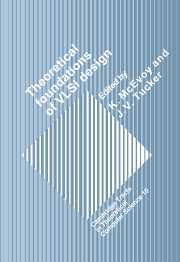Book contents
- Frontmatter
- Contents
- List of contributors
- Preface
- Introduction
- Part 1 Formal methods and verification
- Part 2 Theory and methodology of design
- 5 Formal specification of a digital correlator
- 6 Describing and reasoning about circuits using relations
- 7 The synthesis of VLSI signal processors: theory and example
- Part 3 Methods of circuits and complexity theory
6 - Describing and reasoning about circuits using relations
Published online by Cambridge University Press: 06 November 2009
- Frontmatter
- Contents
- List of contributors
- Preface
- Introduction
- Part 1 Formal methods and verification
- Part 2 Theory and methodology of design
- 5 Formal specification of a digital correlator
- 6 Describing and reasoning about circuits using relations
- 7 The synthesis of VLSI signal processors: theory and example
- Part 3 Methods of circuits and complexity theory
Summary
INTRODUCTION
One of the natural ways to model circuit behaviour is to describe a circuit as a function from signals to signals. A signal is a stream of data values over time, that is, a function from integers to values. One can choose to name signals and to reason about their values. We have taken an alternative approach in our work on the design language μFP (Sheeran [1984]). We reason about circuits, that is functions from signals to signals, rather than about the signals themselves. We build circuit descriptions by ‘plugging together’ smaller circuit descriptions using a carefully chosen set of combining forms. So, signals are first order functions, circuits are second order, and combining forms are third order.
Each combining form maps one or more circuits to a single circuit. The combining forms were chosen to reflect the fact that circuits are essentially two-dimensional. So, they correspond to ways of laying down and wiring together circuit blocks. Each combining form has both a behavioural and a pictorial interpretation. Because they obey useful mathematical laws, we can use program transformation in the development of circuits. An initial obviously correct circuit can be transformed into one with the same behaviour, but a more acceptable layout. It has been shown that this functional approach is particularly useful in the design of regular array architectures (Sheeran [1985, 1986], Luk & Jones [1988a]).
However, sometimes a relational description of a circuit is more appropriate than a functional one.
- Type
- Chapter
- Information
- Theoretical Foundations of VLSI Design , pp. 263 - 298Publisher: Cambridge University PressPrint publication year: 1990
- 7
- Cited by

